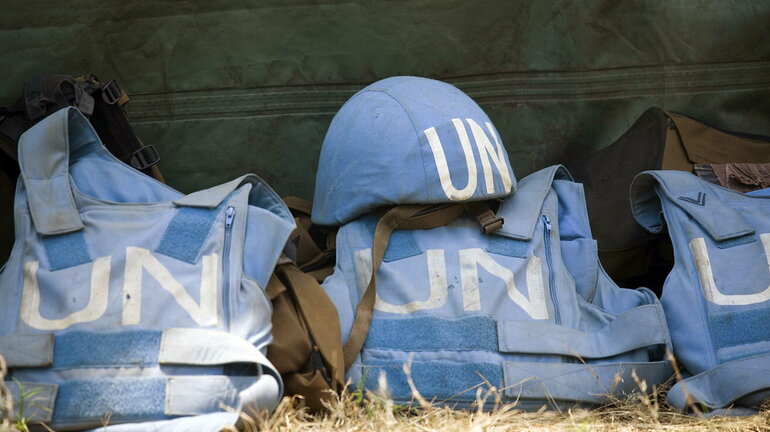A UN Mission for Ukraine’s Donbas?

Ukrainian president Petro Poroshenko has long called for a UN mission for Ukraine’s eastern Donbas region to help with the reintegration of the self-declared Donetsk and Luhansk People’s Republics. Russia has generally ignored these proposals or voiced outright opposition, and the responses by Western powers have been lukewarm at best. The focus has remained firmly on the Minsk agreement, even though implementation of the accord is deadlocked.
On 5 September, Russia surprised Ukraine and the international community by tabling a proposal for the UN Security Council to consider. It envisages a UN peacekeeping mission in the Donbas. Reactions to this proposal have been mixed, but mostly hesitant to critical. German foreign minister Sigmar Gabriel was the most responsive Western politician, coming out strongly in favour of working with the Russian proposal. US special envoy to Ukraine Kurt Volker worded his response more cautiously but also signalled that the proposal had to be considered. This is the right approach, even if many Western and Ukrainian officials are wary after several fruitless attempts to negotiate with Russian president Vladimir Putin and his closest aides.
The Russian proposal has to be taken seriously because peace processes are moving targets. No one agreement, reached at a particular moment in the conflict cycle, can resolve all the issues of an evolving conflict. All sides know this, even though they keep insisting on the full implementation of such agreements. This applies to the Minsk accord as much as to the Dayton Agreement in Bosnia and Herzegovina and many others. What is required is an adjustment of the peace process along the way, and the Russian proposal might just provide such a momentum.
Poroshenko and Ukrainian foreign minister Pavlo Klimkin have combined their scepticism about the Russian proposal with willingness to engage with the idea. But many other Ukrainian voices have condemned the proposal as a cynical move by Russia to increase its pressure on Ukraine.
It is clear from the outset that it will be impossible to reach agreement on the Russian proposal as it stands. According to the proposal, Russia wants the UN mission to concentrate on the contact line that is currently monitored, at least in parts, by the OSCE Special Monitoring Mission (SMM)—or, in the words of Russian officials, to safeguard the security of the OSCE monitors. The UN observers would need access to the occupied territories as a whole, including the Ukraine-Russia border, for the mission to be supported. However, monitoring the entire contact line or the SMM presence generally could be a first step in a phased proposal towards full access. It would mark a moderate improvement on the current situation, where the SMM has only limited access. In a phone call with German chancellor, Angela Merkel Putin apparently stated at the beginning of this week that the UN mission should not be restricted to the contact line but have access to the same territory as the OSCE observers.
Russia currently also intends to make the mission conditional on the involvement of the self-declared republics, which is a nonstarter at the level of the UN. At other levels, however, negotiations are taking place and will have to continue with the involvement of local actors. Similarly, the suggestion that Russian peacekeepers could be part of the UN mission when Russia is a party to the conflict is inconceivable, and Russia’s contribution to stabilization will need to take a different form.
The Russian proposal came in the wake of the US unilaterally strengthening its sanctions regime against Russia and new discussions about the supply of lethal weapons to Ukraine. The proposal also followed a more concerted US effort to engage with the situation on the ground through Volker’s recent appointment. There is a sense that a window for more meaningful negotiations on and off the scenes might be opening, and that this signal is being sent from Moscow. The Donbas and Crimea are different from Moscow’s perspective, so there is a possibility that the economic and medium-term political costs of controlling parts of the Donbas feature in the calculations of key figures in Moscow.
UN missions come in all shapes and sizes. Usually, one looks for a precedent for the situation at hand, but it is the nature of conflicts that they have specific features that determine the scope of a mission and its ultimate success or failure. A closer look at previous cases can therefore be instructive but should not lead to a bias against or in favour of the general idea. At the same time, one has to be realistic about what a mission can achieve, even under favourable circumstances.
Rwanda and Srebrenica in Bosnia and Herzegovina are among the biggest failures where UN missions proved helpless in the face of ethnic cleansing. The UN Observer Mission in Georgia, tasked with enforcing and monitoring the ceasefire between Tbilisi and Abkhazia since the mid-1990s, proved ineffective, could not prevent the Georgia-Russia War in 2008, and ended due to a lack of support for extending the mission’s mandate in 2009.
The case of the UN Transitional Administration in Eastern Slavonia, Baranja, and Western Sirmium (UNTAES), which contributed to a gradual reintegration of Serb-controlled territories into the Croatian state, provides a better, though ultimately also limited parallel. The mission lasted for two years (1996–98), and its mandate combined military, civilian, and administrative tasks. UNTAES comprised close to 3,000 personnel, including over 2,000 troops, about 100 military observers, and several hundred civilian police staff. The figures involved in the UNTAES mission are a useful reminder of what might be required to have an impact. Ideally, the UN would agree on a process of several stages in the Donbas that includes a civilian element focused on territorial administration.
Gwendolyn Sasse is the Director of the Centre for East European and International Studies (ZOiS).